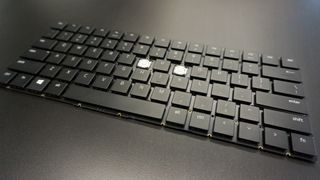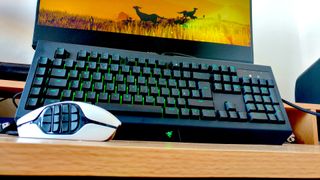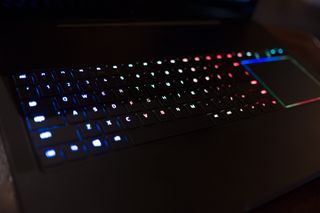How Razer is bringing mechanical keyboards to everything
Keyswitches may sound boring, when in fact, they’re anything but

Razer is arguably best known for its gaming keyboards that have proven to be reliable and popular among professional gamers across the globe. A big factor of that success is what lies beneath the keys. In fact, you could say the company’s drive to develop and build the best mechanical switches in the industry is the key factor that has lead to Razer’s success.
TechRadar recently sat down with Kushal Tandon, product manager, for keyboards and Chroma at Razer to discuss the company’s approach to the mechanical keyswitches so many of us know and love. Below is a transcript of the interview. It has been edited for length and clarity.
- The Razer Blade is one of the best laptops you can buy
TechRadar: Razer just rolled out its third mechanical keyswitch, with Yellow for silenced keystrokes, what has this three year journey been like?
Kushal Tandon: The yellow switch is something we are really proud of and excited to announce. It’s a switch that’s been in development for a very long time.
When we first designed Razer mechanical switches – way back in 2014 – we designed based on a lot of the feedback we got from pro gamers, hardcore keyboard enthusiasts, and those who have been using the BlackWidow family for years.
The BlackWidow family was first announced in 2010, and it set the standard for mechanical keyboards that were designed for gaming. It was back then that we used best in class mechanical switches, Cherry MX. We love Cherry switches and have been using them for awhile.
Through feedback from our users, we learned how they wanted the [Cherry MX] switch to be improved. The fact of the matter is, Cherry MX switches were designed for typing. We subsequently started designing multiple switches, and the Razer Yellow is one that’s been in development for a long time.
Get daily insight, inspiration and deals in your inbox
Get the hottest deals available in your inbox plus news, reviews, opinion, analysis and more from the TechRadar team.
We just recently launched it because development was about perfecting it and it was only now that we thought that switch was perfect.

TR: Beyond the three switches you’ve developed, what else has the journey of building your own switches taught you?
KT: It’s been a very complex, very interesting journey. We jumped right into the actual component level of manufacturing our switches. We have our own dedicated production line.
We own the blueprint for all of our mechanical switches, which is why each switch is perfectly designed and crafted to meet a specific need or want.
What made the journey so interesting is that after we acquired the knowledge from all of the research and development, we learned from manufacturing the switches at the component level, allowing us to think outside the box.
It allowed us to implement this technology in places where one would never think mechanical keyswitch technology could be implemented.
Once you go mechanical, there’s no going back. Once you sit at your desk, typing on your clickity-clack mechanical keys, there essentially is no turning back. We asked ourselves “How do we take that experience and transform it into a device where it can fit into something as thin as an iPad case?”
That was only achieved by all the years we put into our mechanical switches for the BlackWidow line.

TR: What's the development process for a whole new type of device?
KT: It’s all about understanding what our customers want, and what our fan base or users want. It starts with gathering feedback from them.
Our first switch was started based on feedback we received in terms of how people wanted to improve a switch which was great for typing, but didn’t specifically meet the demands of gaming.
The Razer Yellow switch was designed with FPS and MOBA gamers in mind. We felt that the Green and Orange switches were perfect all around switches. They were best for gaming and typing. The green is clicky, the orange is tactile and silent.
For a specific FPS and MOBA titles, there was a slightly different requirement. It all starts with feedback, then we work towards what technology we can implement and bring to market.
We are big fans, some of us in the office, and we all experience typing on the mechanical keyboards and miss it when we are typing on our tablet. That was actually what sprung the iPad keyboard to life.
TR: Speaking of the iPad keyboard, have you guys ever considered creating an iPhone case/keyboard combo to compete with Ryan Seacrest's Typo iPhone case from a few years ago?
KT: I can’t really comment about anything we are working on in terms of future products, but nothing we are doing at the moment is working towards bringing mechanical switches to mobile phones.

TR: I figured that would be the answer, but had to ask. Last March, Razer also introduced a Cherry MX version of the BlackWidow. While Razer wasn't the only one to do this with Logitech G610, but what leads to the decision to swap out your own keyswitches and go back to Cherry?
KT: Fact of the matter is, there is a whole audience out there who use the Razer BlackWidow keyboard and been fans of it since 2010, and they use it for means of everyday typing.
They don’t need the specific advantages that we’ve created with Razer Mechanical Switches.
We listen to our community and get feedback. We’ve given them a Cherry MX switch option because we want a keyboard that can suit everyone’s needs and wants. It’s why the size of the keyboard family is so extensive. We have multiple sizes, form factors, multiple switch types, multiple lighting options, etc.

TR: For the average person, talking about key switches is something that never happens. And when it does, it’s not a very exciting topic. How do you make something like this interesting for the commoner?
KT: It’s fairly simple actually, it’s all about feeling the difference.
As someone who wouldn’t know too much about mechanical keyswitches, and the technicalities, it can get a bit intimidating for the Average Joe. It can even get geeky at times with all the flavors and actuation points, etc.
If you are a person just looking for a good typing experience and a good keyboard, without having to get into any of the specific details, it’s all about just feeling the difference.
The best way to sell our products is for customers just to put their hands on the keyboard and type. If you are someone who is used to typing on a laptop keyboard, experiencing one of our keyboards is enough to start the conversation about our technology and its benefits.
- Which of Razer's products made the cut in our best gaming keyboards list?
TR: Peripherals are more often damaged during transport —drops, knocks, etc. How do you design key switches for that sort of abuse?
KT: Switches go through probably the most stringent quality assurance processes amongst any other component on the keyboard.
Simply put, we have a whole series of tests the switch goes through. That includes drop, vibration, salt mist, extreme temperatures, etc.
The objective is to measure the specifications of each switch in terms of Force Curve: when it actuates, when it’s designed to reset, when it travels for the 80 millionth keystrokes. Our goal is for the Force Curve to remain as intact as possible from keystroke one to keystroke 80 million, and it’s only then that we qualify it to be a Razer Mechanical switch.

TR: Razer has developed clicky, tactile, silent, and mecha-membrane switches so far; does Razer see next or is there a particular keyswitch users are clamoring for?
KT: As you know, clicky, tactile, and silent are the three membranes we have for our keyboards, and mechanical-membrane is the fusion of those.
I think users right now are looking at the way the point of actuation behaves with the point of reset to ensure that they can get the crisp click they like, but at the same speed of something completely linear.
We see the trend going towards speed. People want to move faster, want to actuate faster, but still want the bump. They still want the click. We’re definitely working towards ensuring those points are addressed in some of our future keyboards.
TR: Speaking of the future, what can you tell us about future switches and products?
KT: We are experimenting on the electronic and mechanical side of how these switches behave. We are looking into combining the speed of super lenient switches and the crisp tactility of a clicky switch into a new technology is something we are working towards.

Welcome to TechRadar's 3rd annual PC Gaming Week, celebrating the almighty gaming PC with in-depth interviews, previews, reviews and features all about one of the TechRadar team’s favorite pastimes. Missed a day? Check out our constantly updated hub article for all of the coverage in one place.
Most Popular

